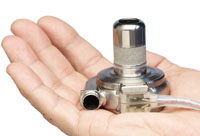The HeartWare Ventricular Assist System is miniaturized ventricular assist device that may be used for the treatment of advanced heart failure. The system is currently being studied in the ADVANCE clinical trial, which is an Investigational Device Exemption study approved by the Food and Drug Administration evaluating the HeartWare for use as a bridge to transplantation in patients with advanced heart failure. In 2009, the device received CE Marking in Europe, and in 2011, the device was granted approval for use in patients in Australia. To date, more than 1500 patients worldwide have received the HeartWare.
The Pump
 A main component of the HeartWare system is its implantable centrifugal blood pump, called the HVAD pump. The pump is implanted and contained completely within the pericardial space. The HVAD pump has only 1 moving part—the impeller. Suspended within the pump using magnets and thrust bearings, the impeller's wide blades are set at an incline. When the impeller spins, blood flows across the inclined surface of the blades, creating a "cushion" between the impeller and the pump housing. A driveline cable, which exits the body through the skin, delivers power to the impeller. The HVAD pump does not have any mechanical bearings, and the impeller's suspended design means there is no contact between the impeller and the pump housing. The HeartWare can be operated at 2400 and 3200 revolutions per minute, which will generate a pump flow rate of up to 10 liters per minute.
A main component of the HeartWare system is its implantable centrifugal blood pump, called the HVAD pump. The pump is implanted and contained completely within the pericardial space. The HVAD pump has only 1 moving part—the impeller. Suspended within the pump using magnets and thrust bearings, the impeller's wide blades are set at an incline. When the impeller spins, blood flows across the inclined surface of the blades, creating a "cushion" between the impeller and the pump housing. A driveline cable, which exits the body through the skin, delivers power to the impeller. The HVAD pump does not have any mechanical bearings, and the impeller's suspended design means there is no contact between the impeller and the pump housing. The HeartWare can be operated at 2400 and 3200 revolutions per minute, which will generate a pump flow rate of up to 10 liters per minute.
The Control System
Pump speeds are controlled by a controller powered either by 2 batteries or by 1 battery and an adapter that can be plugged into a wall or vehicle outlet. The controller monitors the pump function and the remaining power in the batteries. Signals and alarms notify patients of any problems. Both the controller and the batteries are held in a carrying case, which patients can wear around their waist or over their shoulder.
_____
For more information, you can read an article titled, "Implantation of the HeartWare Left Ventricular Assist Device," which appears in Volume 23 (2011) of the journal Seminars in Thoracic and Cardiovascular Surgery (pp. 245-247).
Visit the HeartWare website.



